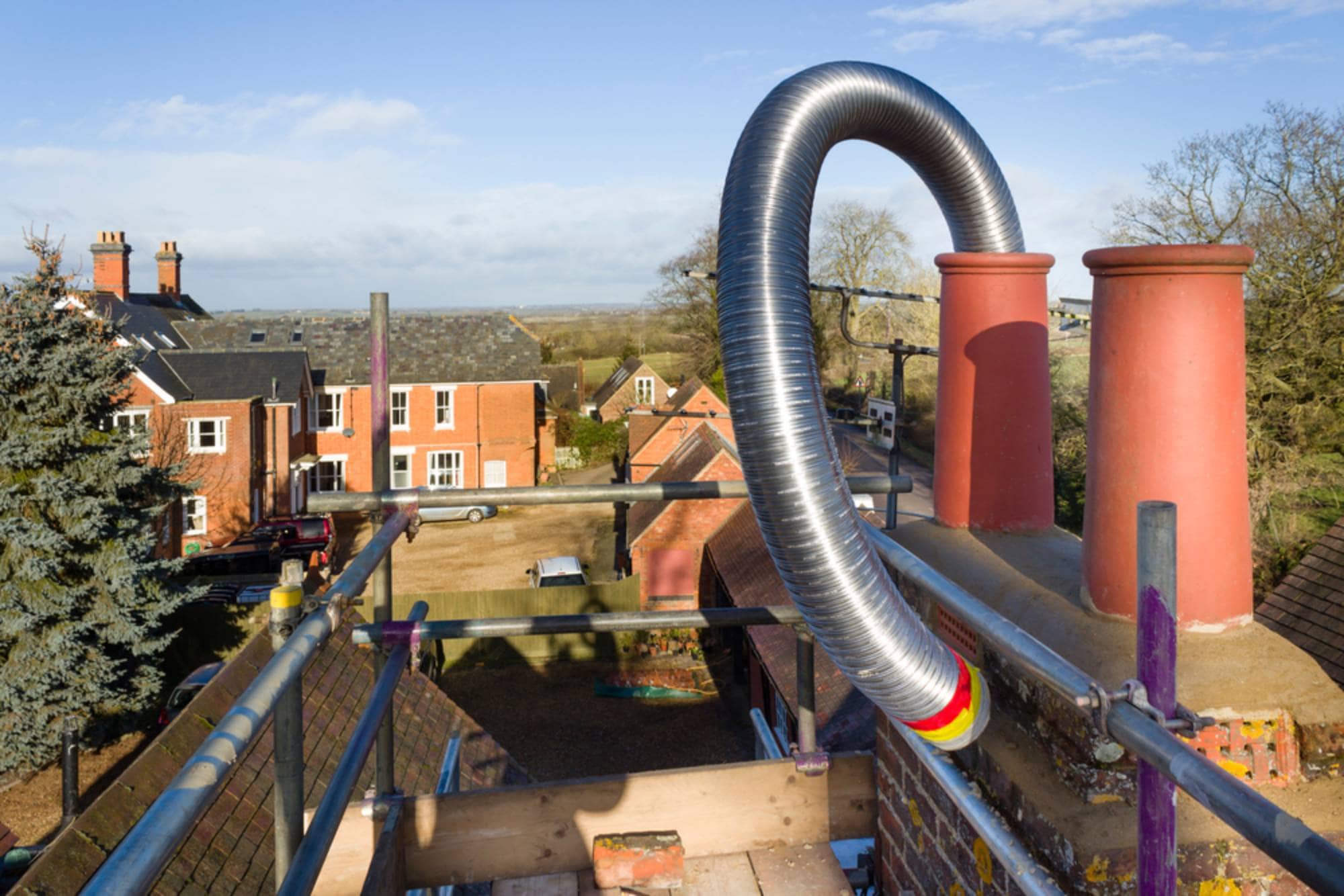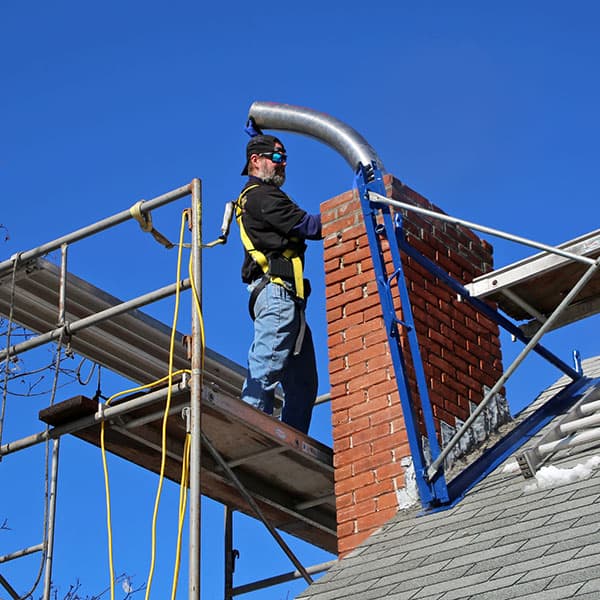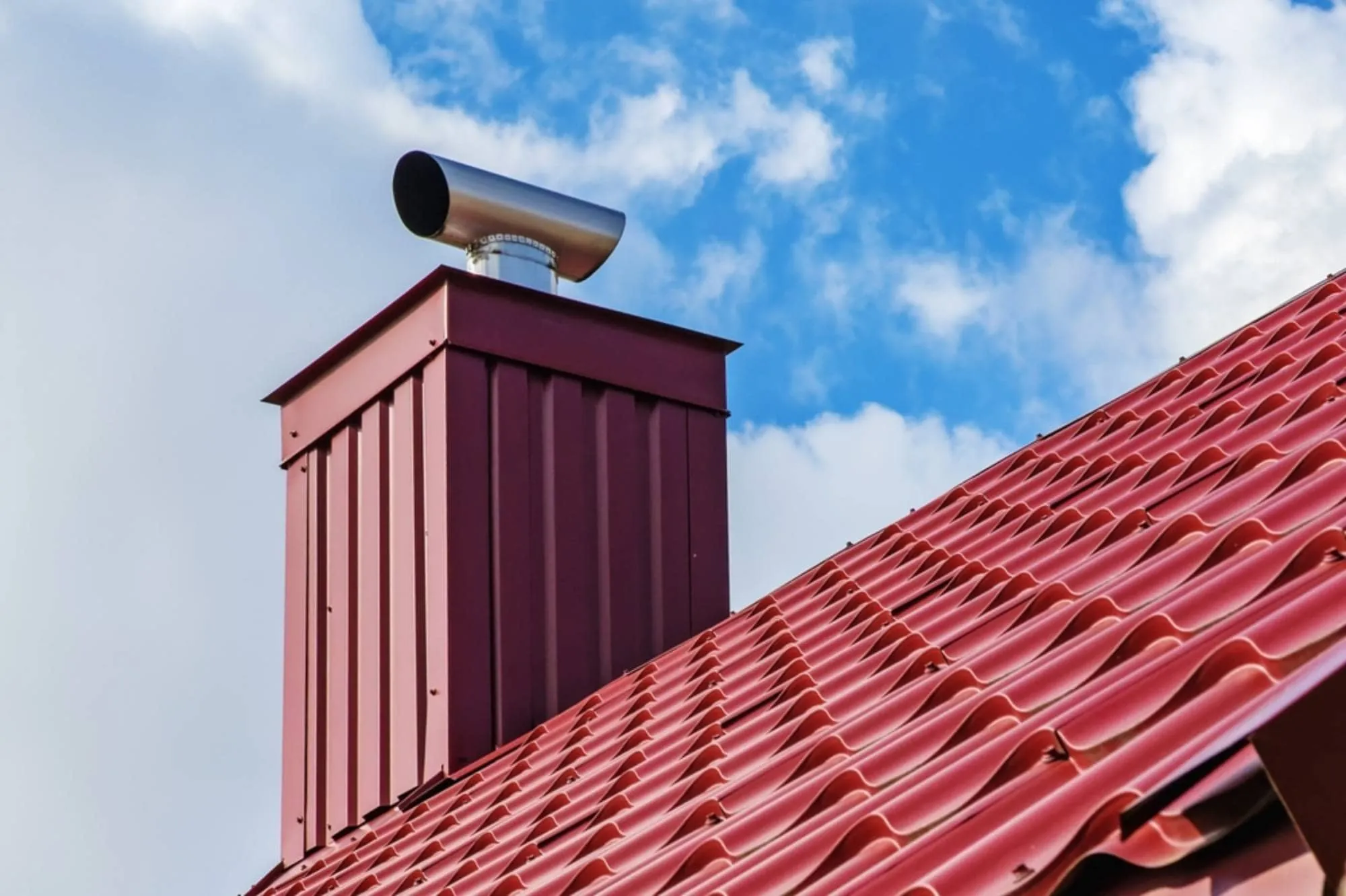Stainless steel chimney liners offer superior protection against Massachusetts weather, lasting up to 25 years while ensuring code compliance and safety.
Share:

Massachusetts weather is tough on chimney systems. The freeze-thaw cycles that crack your driveway every winter do the same thing to clay chimney liners, but worse.
Clay tiles might seem sturdy, but they’re actually brittle. When water gets into tiny cracks and freezes, it expands and splits the clay apart. Over time, those small cracks become big problems that let dangerous gases leak into your home.
Stainless steel doesn’t have this weakness. It flexes with temperature changes instead of cracking, and it won’t absorb moisture that can freeze and cause damage.

Living in Norfolk County means dealing with coastal moisture that most of the country doesn’t face. That humid air doesn’t just make summer days sticky – it gets into your chimney system and causes problems that can take years to show up.
Clay liners absorb this moisture over time. When combined with the acidic byproducts from burning wood, oil, or gas, that moisture becomes corrosive. The result is deterioration that starts from the inside and works its way out, weakening the entire structure.
Stainless steel chimney liners are specifically designed to handle this combination of moisture and corrosive gases. The alloys used in quality liners resist both water damage and chemical corrosion, which is why they can last 20-25 years in conditions that destroy clay liners in half that time.
You’ll also notice better performance right away. Stainless steel liners maintain consistent temperatures, which means better draft and more efficient burning. That translates to less creosote buildup and fewer cleaning headaches.
This isn’t just about durability – it’s about safety. When clay liners crack, they can let carbon monoxide seep into your living space. Stainless steel creates a sealed system that keeps dangerous gases where they belong: going up and out of your home.
Massachusetts building codes require all masonry chimneys to be lined, and those requirements have gotten stricter over the years. If you’re installing new heating equipment or converting fuel types, you need a liner that meets current safety standards.
Many older Norfolk County homes have clay liners that were installed decades ago when standards were different. These systems might have been adequate when they were new, but they don’t necessarily meet today’s requirements for efficiency and safety.
Stainless steel liners that are UL-listed and properly installed meet all current Massachusetts building codes. This matters when you’re selling your home, getting insurance, or having work inspected. You won’t have to worry about costly upgrades or failed inspections.
The installation process also matters for code compliance. Professional installers know the specific requirements for clearances, connections, and safety measures that ensure your system passes inspection the first time. DIY installations or corner-cutting contractors often create problems that are expensive to fix later.
Building inspectors in Norfolk County see the difference between proper installations and shortcuts. When you choose quality materials and professional installation, you’re investing in a system that meets code requirements and gives you peace of mind.
The upfront cost of stainless steel might seem higher than clay, but the math changes when you look at the complete picture. Clay liners typically need replacement or major repairs within 10-15 years, especially in Massachusetts weather conditions.
Stainless steel liners can last 20-25 years with proper maintenance. That means fewer disruptions, less expense over time, and better performance throughout the life of the system.
You’ll also see immediate improvements in how your fireplace or heating system works. Better draft means more efficient burning, which saves fuel and reduces creosote buildup.

A properly sized stainless steel liner creates the right draft for your heating system. This isn’t just technical detail – it directly affects how well your fireplace burns and how much heat you actually get from your fuel.
Clay liners, especially older ones with cracks or rough surfaces, create turbulence that disrupts proper airflow. This leads to incomplete combustion, more smoke, and wasted fuel. You end up burning more wood or gas to get the same amount of heat.
Stainless steel liners have smooth interior surfaces that promote consistent airflow. The result is cleaner burning, better heat output, and less creosote formation. Many homeowners notice the difference immediately – fires start easier, burn cleaner, and produce more heat.
The insulation options available with stainless steel systems add another efficiency benefit. Insulated liners stay warmer, which maintains better draft and reduces condensation problems that can cause odors and damage.
This efficiency improvement isn’t just about comfort – it saves money. When your system burns fuel more completely, you use less of it. Over the 20+ year lifespan of a stainless steel liner, those savings add up significantly.
Temperature consistency is another advantage. Stainless steel doesn’t have the thermal mass of clay, so it responds quickly to changes in heat output. This means better control over your heating system and more consistent performance.
Maintenance costs tell the real story about liner value. Clay liners require frequent inspection and repair because they crack, absorb moisture, and deteriorate from normal use. Each repair means paying for labor, materials, and often scaffolding or equipment rental.
Stainless steel liners need annual cleaning like any chimney system, but they don’t require the constant repairs that clay systems do. The smooth surface cleans more easily, and the corrosion resistance means fewer problems develop between cleanings.
When repairs are needed, they’re typically minor and straightforward. Clay liner repairs often mean removing and replacing individual tiles, which requires dismantling parts of the system. Stainless steel repairs are usually limited to connections or accessories.
The time factor matters too. Clay liner repairs can take days and require multiple trips from contractors. Most stainless steel maintenance can be completed in a single visit, which means less disruption to your schedule and lower labor costs.
Insurance considerations also favor stainless steel systems. Many insurance companies recognize the safety benefits and may offer discounts for homes with properly installed modern liners. They also view stainless steel systems as lower risk, which can affect claims processing if problems do occur.
Professional chimney contractors prefer working with stainless steel because it’s more predictable and reliable. This often translates to better service, more accurate estimates, and fewer surprises during maintenance visits.
Choosing a stainless steel chimney liner isn’t just about buying a product – it’s about investing in a system that protects your home and family for decades. Massachusetts weather, coastal moisture, and aging home infrastructure create challenges that require materials designed to handle these specific conditions.
The upfront investment pays for itself through better performance, fewer repairs, and peace of mind that comes from knowing your system meets current safety standards. When you factor in the 20+ year lifespan and reduced maintenance costs, stainless steel becomes the clear choice for Norfolk County homeowners.
If your home has an older clay liner or no liner at all, don’t wait for problems to develop. The difference between a minor upgrade and a major emergency repair often comes down to timing. We can assess your current system and recommend the right stainless steel solution for your specific needs.
Article details:
Share:
Continue learning: